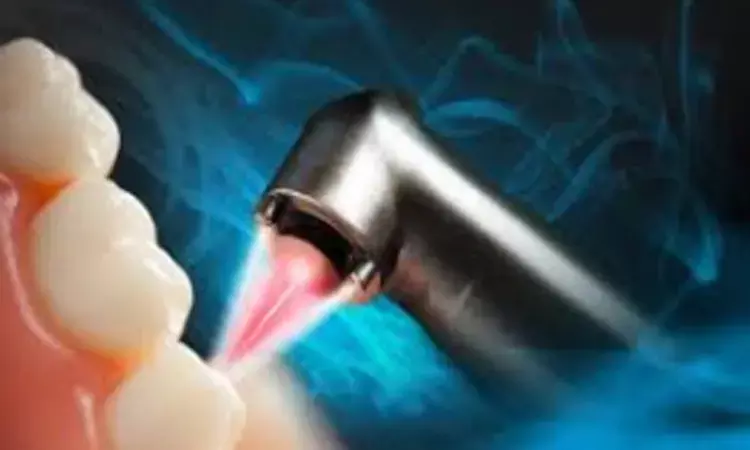- Home
- Medical news & Guidelines
- Anesthesiology
- Cardiology and CTVS
- Critical Care
- Dentistry
- Dermatology
- Diabetes and Endocrinology
- ENT
- Gastroenterology
- Medicine
- Nephrology
- Neurology
- Obstretics-Gynaecology
- Oncology
- Ophthalmology
- Orthopaedics
- Pediatrics-Neonatology
- Psychiatry
- Pulmonology
- Radiology
- Surgery
- Urology
- Laboratory Medicine
- Diet
- Nursing
- Paramedical
- Physiotherapy
- Health news
- Fact Check
- Bone Health Fact Check
- Brain Health Fact Check
- Cancer Related Fact Check
- Child Care Fact Check
- Dental and oral health fact check
- Diabetes and metabolic health fact check
- Diet and Nutrition Fact Check
- Eye and ENT Care Fact Check
- Fitness fact check
- Gut health fact check
- Heart health fact check
- Kidney health fact check
- Medical education fact check
- Men's health fact check
- Respiratory fact check
- Skin and hair care fact check
- Vaccine and Immunization fact check
- Women's health fact check
- AYUSH
- State News
- Andaman and Nicobar Islands
- Andhra Pradesh
- Arunachal Pradesh
- Assam
- Bihar
- Chandigarh
- Chattisgarh
- Dadra and Nagar Haveli
- Daman and Diu
- Delhi
- Goa
- Gujarat
- Haryana
- Himachal Pradesh
- Jammu & Kashmir
- Jharkhand
- Karnataka
- Kerala
- Ladakh
- Lakshadweep
- Madhya Pradesh
- Maharashtra
- Manipur
- Meghalaya
- Mizoram
- Nagaland
- Odisha
- Puducherry
- Punjab
- Rajasthan
- Sikkim
- Tamil Nadu
- Telangana
- Tripura
- Uttar Pradesh
- Uttrakhand
- West Bengal
- Medical Education
- Industry
Diode lasers beneficial for implant stage 2 recovery procedures, Finds study

Diode laser and erbium, chromium-doped yttrium, scandium, gallium, and garnet (Er, Cr:YSGG) laser systems, both show certain advantages. Less anesthesia, less surgical trauma and faster healing, and post-operative comfort, lasers on the whole are an effective tool for implant stage two recovery techniques. However, diode lasers are more cost effective when compared to Er, Cr:YSGG, diode lasers may meet the clinical needs when compared to hard-tissue lasers, reports a study published in the Journal of Indian Society of Periodontology.
Sahana Selvaganesh and colleagues from the Department of Implantology, Saveetha Dental College, Saveetha Institute of Medical and Technical Sciences, Chennai, Tamil Nadu, India aimed to compare the clinical efficacy of diode laser and erbium, chromium-doped yttrium, scandium, gallium, and garnet (Er, Cr:YSGG) laser for implant stage 2 recovery procedure.
A total of 30 patients who had undergone dental implant placement were included in this study. The subjects were randomly allocated into three groups. Group 1 patients (n = 10) had implant recovery using diode laser, Group 2 (n = 10) implant recovery with Er, Cr:YSGG and conventional scalpel method (n = 10) was the third group.
The pain assessment was recorded using visual analog scale (VAS scale), time taken for the procedure, intra-operative bleeding, time taken for healing were recorded for the three groups.
The following observations were highlighted-
- Data were tabulated and the results were analyzed using SPSS software version 26. Mann–Whitney U-test was used to compare the postoperative analgesic used, postoperative VAS score, the time taken for recovery and time taken for healing between the three study groups.
- Results were considered to be statistically significant when P < 0.05.Operation duration under Er, Cr:YSGG were much faster than the diode laser, however the results were not statistically significant (P = 0.051).
- The operation time under Er, Ch: YSGG and laser were faster than the conventional scalpel group (P = 0.000).
- The time taken for healing was faster in the Er, Cr:YSGG laser group than the diode laser and the scalpel group (P = 0.000).
- VAS scale at day 0 was higher in the conventional group than the two laser groups (P = 0.000).
Hence, the authors concluded that considering the advantages of both these laser systems such as less anesthesia, less surgical trauma and faster healing, and post-operative comfort, lasers are an effective tool for implant stage two recovery techniques. However, since diode lasers are more cost effective when compared to Er, Cr:YSGG, diode lasers may meet the clinical needs when compared to hard-tissue lasers.
Selvaganesh S, Gajendran PL, Nesappan T, Prabhu AR. Comparison of clinical efficacy of diode laser and erbium, chromium: Yttrium, scandium, gallium, and garnet for implant stage 2 recovery procedure – A randomized control clinical study. J Indian Soc Periodontol 2021;25:335-40
Dr. Nandita Mohan is a practicing pediatric dentist with more than 5 years of clinical work experience. Along with this, she is equally interested in keeping herself up to date about the latest developments in the field of medicine and dentistry which is the driving force for her to be in association with Medical Dialogues. She also has her name attached with many publications; both national and international. She has pursued her BDS from Rajiv Gandhi University of Health Sciences, Bangalore and later went to enter her dream specialty (MDS) in the Department of Pedodontics and Preventive Dentistry from Pt. B.D. Sharma University of Health Sciences. Through all the years of experience, her core interest in learning something new has never stopped. She can be contacted at editorial@medicaldialogues.in. Contact no. 011-43720751
Dr Kamal Kant Kohli-MBBS, DTCD- a chest specialist with more than 30 years of practice and a flair for writing clinical articles, Dr Kamal Kant Kohli joined Medical Dialogues as a Chief Editor of Medical News. Besides writing articles, as an editor, he proofreads and verifies all the medical content published on Medical Dialogues including those coming from journals, studies,medical conferences,guidelines etc. Email: drkohli@medicaldialogues.in. Contact no. 011-43720751


